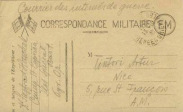It lodged 90,000 refugees in March 1939 in shelters of fortune miraculiously maintained in spite of the gusts of wind. Only the casualties and the patients could find place in huts.

Letter dated 6-10-1939 and destinated to the S.E.R.E. (Servicio de Evacuación a los Refugiados Españoles).

A delegate of the C.I.C.R. submitted a report about the visits he did between the 17th and the 25th of June in the camps of the southern zone. He recorded in particular the painfulness of the conditions of internment bound, according to him, with the massive surge of the internees. He underlined the arrival of 7500 internees to the CAMP OF ST-CYPRIEN of which 1000 were of the "Reichsdeutsche" (German, Autrichiens, Sudètes) coming from Belgium.
One estimates at approximately 2500 those which were finally repatriated in July-August 1940. As for the Jews of Belgium, most with ST-CYPRIEN, their repatriation was prohibited by the German authorities.
In October 1940, thousands of Jews from Bade, Palatinat and the Saar were expelled and found refuge in the camps of the southern zone, except probably with ST-CYPRIEN which had to be evacuated following very serious floods which occurred in October 1940. 3870 internees of ST-CYPRIEN arrived indeed to GURS between October, 1940 the 29th and the 31rd.
As of the summer 1940, the internees forwarded with the C.I.C.R. a sharp protest against the inhuman conditions of their detention:
Water badly filtered for drink and food; Open W.C.; flies in quantity such as they are unbearable; mouse, rats, chips and lice; insufficient, partially infested straw mattresses vermin; defective hutments; malnutrition; miss clothing and underclothing; almost complete absence of drugs, disinfecting and articles of hygiene.
85% of the internees were reached of dysentery in August 1940. At the same time, an epidemic of typhoide involved the hospitalization of 112 patients at the St-Louis Hospital of PERPIGNAN. 17 died in less than three weeks. A antityphic vaccination was practised as from August 22 only.
Little time after, 150 internees was reached malaria that an important lack of drugs did not make it possible to look after suitably.
A report of the doctors establishes that the water used in the camp was polluted by colon bacilli of fecal origin. The underground sheet of water was indeed in direct communication with stagnant liquid tablecloths located under the urinals and the latrines!
It became extremely urgent to evacuate the internees but one needed the serious floods which invaded the camp as from October 16 to precipitate the movement.
The camp was closed on October 30, 1940.
DISCOMFORT, PROMISCUITE, SALETE, COLD... Such are the painful living conditions imposed to the internees in French camps! The majority supported it very badly: " the conditions under which one lives here is dreadful, it is the end of the culture" writes an internee of ST-CYPRIEN to rabbi CHNEERSON on November 24, 1940.

Postcard addressed of frankness and posted at ELNE 5Pyrenees-Eastern) on October 13, 1940 destinated to NICE (Alpes-Maritimes). It is a military postcart used by the internee who marked with the pencil "Mail of the internees of war".


Postcard posted at ELNE on October 23, 1940 destinated to New York (U.S.A.) and freed
to 1,50 F. At this date, the camp was flooded and the shipper precise:
"At the beginning of next week, we will go in another camp".
It was the evacuation towards GURS!


Postcard posted in frankness at ELNE on October 24, 1940 destinted to MONTREUX (Swiss). It thus was sent right before the transfer to GURS and presents a rare circular seal "CAMP OF ST-CYPRIEN Service of the Information" and the handwritten indication "Posts prisoners of war" (sic).

19/05/2006
